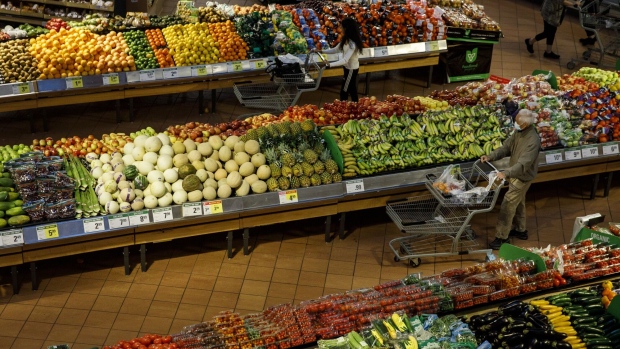Mar 19, 2024
Canada Inflation Slows to 2.8%, Below Expectations
, Bloomberg News

(Bloomberg) -- Canadian inflation unexpectedly eased in February, building a case for the Bank of Canada to pivot to less restrictive policy in the coming months.
The consumer price index rose 2.8% last month from a year ago, following a 2.9% increase in January, Statistics Canada reported Tuesday in Ottawa. That’s the slowest pace since June and below the median estimate of 3.1% in a Bloomberg survey of economists.
Traders boosted their bets on a June rate cut, pricing in around a three-quarters chance of one. The odds were about 50/50 on Monday.
The Canadian dollar weakened and bonds surged, pushing the yield on two-year Canadian government debt to 4.16%, down about 14 basis points on the day. That’s the biggest intraday drop since Feb. 20.
On a monthly basis, the CPI climbed 0.3%, versus expectations for a 0.6% increase, and rose 0.1% on a seasonally adjusted basis.
The Bank of Canada’s two preferred core inflation measures also slowed, averaging a 3.15% yearly pace from 3.35% a month earlier, slower than the 3.35% expected. A three-month moving average of the rate fell to an annualized pace of 2.23%, from 3.12% in January. Other key core measures also showed disinflation.
The new data bolsters the case for policymakers to soon take their foot off the monetary brake. Bank of Canada officials have said they’re waiting for enough data to convince them that inflation is on a sustained march to the 2% inflation target before they begin cutting interest rates.
This is the only inflation report before the next rate decision on April 10, when the central bank will also update its economic projections. Economists widely expect the bank to hold policy rates at 5% for a sixth straight meeting, with the easing cycle to begin around midyear.
“With ample evidence that higher interest rates are working to tame inflation, the Bank of Canada is on track to start cutting interest rates in June,” Katherine Judge, chief market strategist at Canadian Imperial Bank of Commerce, wrote in a report to investors.
What Bloomberg Economics Says...
“February’s CPI report marks the second straight downside inflation surprise, adding to the list of reasons why the BoC will start inching toward a policy-rate pivot. Still, the pace of disinflation has slowed and become more volatile over the past year, while the pace of hiring has picked up in recent employment reports. For a cautious Bank of Canada considering the totality of the data, the current landscape still supports staying on hold in the near-term.”
— Stuart Paul, US and Canada Economist
For the full analysis, click here
Simon Harvey, head of foreign exchange analysis at Monex Canada, argued that by delaying any decision to cut until June, the Bank of Canada runs the risk of maintaining an overly restrictive policy for too long.
“As we have been warning since late November, the Canadian economy is much weaker than the headline data suggests, and we’re now starting to see that weakness manifest within nearly all macro indicators,” he said in an email.
But Citigroup economist Veronica Clark said the central bank “will need more than the minimum evidence inflation has slowed. We continue to expect the first cut in July.”
Housing Inflation
At the rate announcement earlier this month, Governor Tiff Macklem said policymakers needed to “give higher rates more time to do their work.” The central bank projected inflation to remain close to 3% through the middle of this year before easing in the second half.
On a seasonally unadjusted monthly basis, February is typically the hottest month of the year for price increases. That makes this month’s weaker print more significant.
In February, declining prices for mobile and internet services, and a deceleration in grocery inflation, helped offset higher gasoline prices, which climbed 0.8% from a year earlier.
Read More: Early Signals Are Showing Cooling Wage Growth in Canada
Mortgage interest costs and rent remained the biggest contributors to the annual change in the rate of inflation. Mortgage interest costs jumped 26.3% from a year ago and rent grew 8.2%. Excluding shelter costs, the consumer price index rose 1.3% from a year ago.
Excluding food and energy, the consumer price index was up 2.8%. Services inflation held steady at 4.2%.
Regionally, prices increased at a slower annual pace in February compared with January in seven provinces. Manitoba and Alberta saw inflation rise at a quicker pace, with the latter province seeing faster gains in part due to natural gas prices.
“It’s difficult to poke any holes in this report,” Doug Porter, chief economist at Bank of Montreal, wrote in a report to investors. “We’re not the only analysts caught by surprise at how modest these inflation rates of the past two months have been (and especially in contrast to the high-side and sticky readings in the US).”
“At a minimum for April, look for the bank to open the door to rate cuts. BMO continues to call for a June start to rate cuts, and this report certainly reinforces our conviction.”
--With assistance from Jay Zhao-Murray and Erik Hertzberg.
(Updates market reaction beginning in the third paragraph and adds more reaction from economists.)
©2024 Bloomberg L.P.





